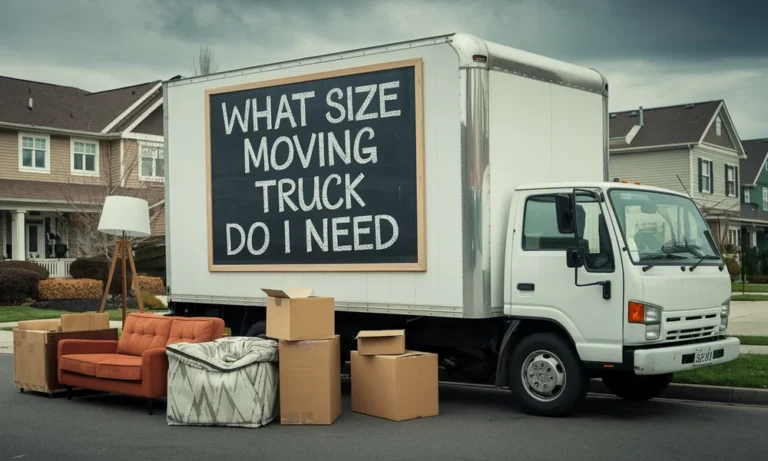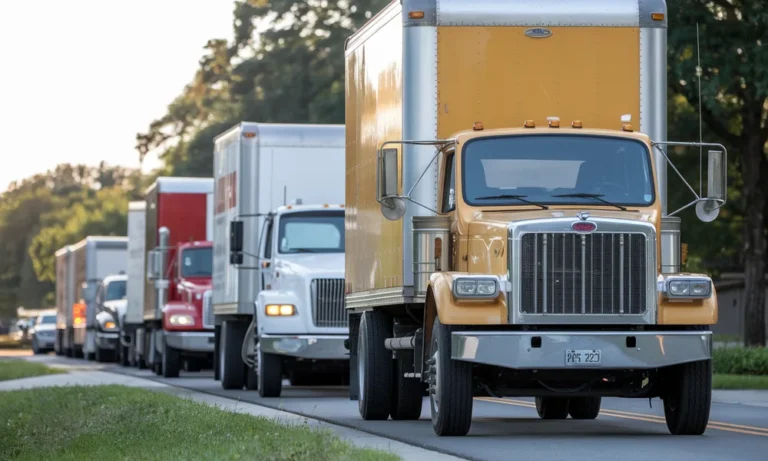What size moving truck do I need? Choosing the right truck size depends on the size of your home and the number of belongings you’re moving. A 10-12 foot truck is good for a studio or 1-bedroom apartment, while a 20-26 foot truck works for larger homes. Consider the type of furniture, fragile items, and any special needs for your move. It’s also important to think about truck features like fuel efficiency and ease of driving, especially if you’re new to handling large vehicles. Properly estimating your items and checking with the rental company for recommendations can help ensure you pick the right size.
How to Calculate the Right Size of Truck for Moving

When planning a move, choosing the right moving truck size is crucial to ensure you can fit all your belongings while avoiding unnecessary trips or extra costs. Here’s a breakdown of common moving truck sizes, their typical load capacities, and their benefits and drawbacks.
10-Foot Truck
- Capacity: This is the smallest truck available for rental. It can hold around 1-2 rooms of furniture, making it ideal for a small apartment, dorm room, or studio.
- Average Weight Capacity: Typically, a 10-foot moving truck can handle up to 2,000-3,000 pounds.
- Benefits: Perfect for small moves; it’s easy to maneuver in tight spaces and requires less fuel.
- Drawbacks: Limited space means it might not be suitable for larger homes or moves with more items. You may need to make multiple trips.
15-Foot Truck
- Capacity: This truck is better for a small house or a 1-2 bedroom apartment. It can hold about 2-3 rooms worth of furniture and belongings.
- Average Weight Capacity: Usually, it can support up to 4,000 pounds.
- Benefits: Offers more space than the 10-foot truck while still being relatively easy to drive.
- Drawbacks: It might still feel a bit cramped for larger moves, and depending on your load, you might need to optimize packing.
20-Foot Truck
- Capacity: This size is great for larger apartments, 2-3 bedroom homes, or if you have a lot of items like furniture, appliances, and boxes.
- Average Weight Capacity: Typically supports between 6,000-7,000 pounds.
- Benefits: Ideal for larger moves; offers good capacity without requiring a large moving team. It’s spacious but not too large to handle.
- Drawbacks: Slightly more challenging to maneuver than smaller trucks, and fuel consumption can be higher. You might need to pack carefully to avoid wasting space.
26-Foot Truck
- Capacity: The largest truck size available for moving, this truck can carry the contents of a 3-4 bedroom home or even more, depending on the layout of your space. It’s perfect for large families or those with lots of heavy items like couches, large appliances, and more.
- Average Weight Capacity: A 26-foot truck can typically hold up to 10,000 pounds.
- Benefits: Maximum capacity means fewer trips and fewer moving expenses if you’re trying to save on mileage. It’s best for large-scale moves.
- Drawbacks: Difficult to drive, especially in urban areas or tight spaces. It can also be more expensive to rent due to its size, and its large footprint means it requires more parking space.
How to Choose the Right Moving Truck Size
When choosing from these moving truck sizes, it’s important to consider:
- The amount of stuff you have: A good rule of thumb is to estimate how many rooms your belongings fill. A 10-foot truck works well for 1-2 rooms, while a 26-foot truck is necessary for larger homes.
- The weight of your items: Be mindful of the weight capacity. Exceeding the weight limit can cause issues, including damage to the truck.
- Distance of your move: If you’re moving a long distance, renting a larger truck might help you save on multiple trips, even though it comes with higher fuel costs.
- Your comfort with driving a larger truck: If you’re not accustomed to driving larger vehicles, consider renting a smaller truck to make the process smoother.
You can also read about Packing services in Los Angeles.
How to Calculate the Right Size of Truck for Moving
Choosing the right moving company truck sizes is crucial to ensure your move goes smoothly. Selecting the proper truck helps avoid making extra trips or overloading the vehicle. Here’s a step-by-step guide to determine the right size truck for your move.
1. Consider the Number of Rooms in Your Home
Start by estimating how many rooms your home has. A general rule of thumb is:
- Studio/1-Bedroom Apartment: A 10-foot truck should be sufficient.
- 2-Bedroom Apartment/House: A 15-foot truck is ideal for moves with 2 bedrooms.
- 3-Bedroom House: A 20-foot truck is typically needed.
- 4+ Bedroom House: A 26-foot truck will likely be required for larger homes.
2. Evaluate the Size and Weight of Large Furniture Items
Larger furniture like sofas, refrigerators, and beds take up significant space, so it’s essential to account for them when choosing the truck size. Here’s a quick estimate of their space requirements:
- Sofas/Sectionals: Around 20-60 cubic feet, depending on size.
- Refrigerators: Typically 40-60 cubic feet.
- Beds: A queen or king-size bed can take up about 50-60 cubic feet.
- Dining Tables: Around 40-50 cubic feet.
Sum up the cubic feet of your large furniture to help determine how much space they’ll need in the truck.
3. Assess the Volume of Boxes and Other Belongings
Consider the volume of smaller items such as boxes, clothing, and kitchenware. Each box can take up around 1-5 cubic feet, depending on its size. Estimate the number of boxes and their sizes to get a better idea of how much space you’ll need.
For example:
- Small boxes: 1-2 cubic feet.
- Medium boxes: 3-4 cubic feet.
- Large boxes: 4-6 cubic feet.
Volume Estimation: Understanding Cubic Feet
Cubic feet measures the total space available in a truck. Here’s how it typically breaks down:
- 10-foot truck: 400-500 cubic feet.
- 15-foot truck: 700-800 cubic feet.
- 20-foot truck: 1,000-1,200 cubic feet.
- 26-foot truck: 1,600-1,800 cubic feet.
To estimate how much space you need, sum up the cubic footage of your items and compare it to the truck’s capacity.
Tips for Packing Efficiently
Efficient packing is key to maximizing space in your moving company truck sizes. Here are some helpful tips:
- Disassemble Furniture: Take apart large furniture like beds and tables to save space.
- Use Soft Items for Padding: Clothes and blankets can protect fragile items and fill empty spaces in the truck.
- Pack Vertically: Stack smaller boxes vertically to make the most of the truck’s height and space.
- Use Every Inch: Fill every gap with smaller items to avoid wasting space.
By packing efficiently, you may be able to fit more into a smaller truck, potentially saving on costs and trips.
Other Things to Consider Before Choosing a Truck Size

When deciding what size truck do I need for your move, it’s important to consider more than just the number of rooms in your home. Several factors can impact the truck size you choose, from the distance of your move to potential weather challenges. Here are some additional considerations to keep in mind.
1. Distance of the Move
The distance of your move plays a significant role in determining the truck size. Local moves are usually more flexible with truck size because you can make multiple trips if necessary. However, for long-distance moves, it’s often more economical to rent a larger truck so that you only need to make one or two trips.
- Local Move: If you’re moving locally, you might be able to get away with a smaller truck, as you can easily come back for extra loads.
- Long-Distance Move: For long-distance moves, a larger truck can save time and money by reducing the number of trips and the total amount of fuel consumed. In this case, the bigger truck might be necessary to avoid wasting time on multiple smaller trips.
2. Accessibility at Pickup and Drop-off Locations
Before deciding on what size truck do I need, think about the accessibility of both your current home and the destination. Are there any parking or road size limitations at either location? Large trucks, such as the 26-foot models, can be difficult to park and maneuver, especially in narrow streets or driveways.
- Narrow Streets: If your pickup or drop-off location is on a street with limited space, a smaller truck (like a 10-foot or 15-foot truck) might be a better choice.
- Stairs: If you live in an apartment or house with stairs and limited parking, a smaller truck might help ease the process. Sometimes, choosing a truck that can be parked closer to the entrance will make moving easier and reduce the need for additional trips or time spent walking back and forth.
3. Weather and Seasonal Factors
The weather can significantly affect your move, especially during rainy or snowy seasons. If you’re moving during harsh weather conditions, such as rain or snow, you may need to consider a truck with more space for protective packing or for sheltering items while loading and unloading. In some cases, a larger truck can help by allowing you to consolidate your items more efficiently under a larger roof, minimizing the time spent outside in bad weather.
- Rain and Snow: A bigger truck may be more beneficial for covering your items quickly during a storm. Having the extra space can also help ensure that you don’t need to rush, allowing you to move your belongings in a more controlled manner.
- Extreme Heat: During hot weather, a large truck will allow you to keep your belongings better organized, making it easier to load quickly, preventing exposure to the sun for extended periods.
4. Time Considerations
If you’re on a tight schedule and need to complete your move in a short amount of time, a larger truck can save you the trouble of making multiple trips. This is especially true for moves that involve a lot of furniture or numerous boxes. In cases where time is critical, choosing the right size truck will help you transport all your belongings in a single trip, making the move faster and less stressful.
- Tight Deadline: If you have a strict deadline, it’s better to opt for a larger truck to save time and minimize the risk of delays due to multiple trips or inefficiencies in loading/unloading.
- Extended Timeframe: If you have more time to complete your move, renting a smaller truck might work better, as it can be less expensive and easier to handle.
5. Cost of Renting a Truck
The size of the truck you choose can impact the overall cost of your move, so it’s important to consider your budget when deciding what size truck do I need. Larger trucks usually come with higher rental fees, and you’ll also need to factor in the costs for fuel, insurance, and other expenses related to truck rental.
- Rental Fees: Larger trucks generally have higher daily or hourly rental rates. If you’re trying to save money, opting for a smaller truck that still fits all your items can make a significant difference.
- Fuel Costs: Bigger trucks consume more fuel, so if you’re moving a long distance, this will increase your overall moving costs. Be sure to calculate the estimated fuel expenses for your move and compare them against the cost of renting a larger vehicle.
- Insurance: Many moving companies offer insurance to cover damages during the move. Larger trucks might have higher insurance costs, so it’s worth asking about these fees when determining the size you need. For moving services in Los Angeles contact no other than Chamomile Go.
Common Mistakes to Avoid When Choosing a Moving Truck Size
Choosing the right moving truck size is essential for a smooth and efficient move. However, there are several common mistakes people make when determining the size they need. Avoiding these pitfalls will help ensure you select the best truck for your needs, making your move less stressful and more cost-effective.
1. Overestimating or Underestimating the Required Space
One of the most common mistakes people make is either overestimating or underestimating the amount of space they need in a truck.
- Overestimating: Renting a truck that is too large can lead to wasted space, higher rental fees, and increased fuel costs. You might think a bigger truck will make the move easier, but in many cases, it can be more challenging to fill a larger vehicle efficiently.
- Underestimating: On the other hand, renting a truck that’s too small can lead to multiple trips or cramped packing, potentially causing damage to your belongings. Underestimating your space needs often leads to last-minute stress as you realize the truck isn’t big enough for all your items.
To avoid this mistake, it’s important to assess the volume of your belongings carefully. Think about what to move first when moving, especially larger pieces of furniture. This will give you a better sense of how much space you’ll need.
2. Not Considering the Type of Furniture and Fragile Items
Another mistake is not properly considering the size, weight, and fragility of your furniture and items. Larger furniture pieces like sofas, refrigerators, and beds take up more space than you might expect. Additionally, fragile items, such as glass furniture, artwork, or electronics, require more careful handling and extra packing materials.
- Large Furniture: Sofas, dining tables, and appliances often require special consideration. These items may need to be disassembled or arranged in a specific way to maximize truck space.
- Fragile Items: For delicate items, you may need extra packing materials like bubble wrap or moving blankets. It’s important to ensure your truck has enough room to accommodate these items safely, as cramming them into tight spaces could lead to damage.
When determining what size truck do I need, take into account not just the number of rooms or boxes, but also how much space your large or fragile items will require.
3. Forgetting to Account for Special Circumstances Like Stairs, Elevators, or Limited Access
Many people overlook the logistics of loading and unloading their truck, especially when there are stairs, narrow hallways, or limited access to parking. If you’re moving from a home with stairs or into a building with an elevator, it may take longer to load and unload, and you might need more space in the truck to account for these challenges.
- Stairs and Elevators: If there are stairs at either the pickup or drop-off location, it could slow down the moving process, meaning you might need more time and space to load the truck efficiently. Similarly, if you’re dealing with elevators, this could also impact how you pack and load the truck.
- Limited Access: If your current home or new location has narrow roads or limited parking space, you might not be able to park a large truck close to the entrance. This can require multiple trips or a smaller truck, as maneuvering a large vehicle could be difficult.
Make sure to assess the layout of both locations and take into account any potential access issues before deciding on what size truck do I need. This will help you avoid delays and frustration on moving day.
Final Thoughts
If you’re planning a move in Los Angeles and wondering what size moving truck you need, Chamomile Go is here to help! Whether you’re moving a studio apartment or a large family home, we have the right truck for the job. Our expert team can assist you with packing services to make your move even easier. We provide reliable, professional service to ensure your belongings are transported safely. Don’t stress about the details contact Chamomile Go today at +1 310-895-3517 and let us take care of the rest! We’re here to make your move smooth and hassle-free.
FAQs
What Size Moving Truck Do I Need For A 1-Bedroom Apartment?
For a 1-bedroom apartment, a 10-12 foot moving truck is usually sufficient. It can fit the contents of a small apartment, including furniture like a bed, couch, and a few boxes.
What Size Truck Do I Need For A 2-Bedroom Apartment Or House?
A 14-17 foot moving truck should work well for a 2-bedroom apartment or house. This size can typically accommodate larger furniture, such as two beds, a sofa, dining room table, and multiple boxes.
Do I Need A Bigger Truck For A 3-Bedroom House?
Yes, for a 3-bedroom house, you’ll likely need a 20-24 foot moving truck. This size truck can fit larger furniture, appliances, and several rooms of belongings.
How Do I Determine The Right Truck Size For My Move?
The right truck size depends on the number of rooms you need to move, the volume of furniture, and how much packing material you plan to use. Our moving experts can help you assess your needs for a more accurate estimate.
Can I Fit Everything Into A Smaller Truck If I Pack Efficiently?
While it’s possible to fit everything into a smaller truck by packing efficiently, it’s important to account for the total space your belongings will take up. A truck that’s too small might result in multiple trips or require you to leave things behind.
